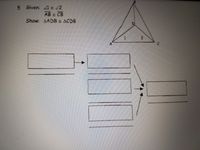
Elementary Geometry For College Students, 7e
7th Edition
ISBN: 9781337614085
Author: Alexander, Daniel C.; Koeberlein, Geralyn M.
Publisher: Cengage,
expand_more
expand_more
format_list_bulleted
Question
thumb_up100%

Transcribed Image Text:### Geometry Problem and Proof Diagram
**Problem Statement:**
5. **Given:**
- \(\angle 1 \equiv \angle 2\)
- \(AB \equiv CB\)
**Show:**
- \(\triangle ADB \equiv \triangle CDB\)
**Diagram:**
- The diagram is a triangle \(ABC\) with a point \(D\) on side \(BC\), creating two smaller triangles: \(\triangle ADB\) and \(\triangle CDB\).
**Flowchart:**
1. **First Box:**
- This box is presumably the starting point of the proof, containing initial givens or assumptions based on the problem statement.
2. **Second Box:**
- Arrows indicate a logical progression from the first box to this one. It likely contains derived equalities or congruences stemming from the initial conditions.
3. **Third Box:**
- Following the same logic progression, this box would further develop the proof using previously established information.
4. **Fourth Box:**
- Two arrows pointing towards this final box suggest it contains the culmination of the logical arguments provided in the earlier steps, ultimately showing the congruence of \(\triangle ADB\) and \(\triangle CDB\).
**Explanation:**
The problem involves proving the congruence of triangles \(\triangle ADB\) and \(\triangle CDB\) using the given angle and side congruences. The flowchart provides a structured method to derive this conclusion, typically using geometric congruence postulates such as ASA (Angle-Side-Angle) or SAS (Side-Angle-Side).
Expert Solution
This question has been solved!
Explore an expertly crafted, step-by-step solution for a thorough understanding of key concepts.
This is a popular solution
Trending nowThis is a popular solution!
Step by stepSolved in 2 steps with 2 images

Knowledge Booster
Learn more about
Need a deep-dive on the concept behind this application? Look no further. Learn more about this topic, geometry and related others by exploring similar questions and additional content below.Similar questions
Recommended textbooks for you
 Elementary Geometry For College Students, 7eGeometryISBN:9781337614085Author:Alexander, Daniel C.; Koeberlein, Geralyn M.Publisher:Cengage,
Elementary Geometry For College Students, 7eGeometryISBN:9781337614085Author:Alexander, Daniel C.; Koeberlein, Geralyn M.Publisher:Cengage, Elementary Geometry for College StudentsGeometryISBN:9781285195698Author:Daniel C. Alexander, Geralyn M. KoeberleinPublisher:Cengage Learning
Elementary Geometry for College StudentsGeometryISBN:9781285195698Author:Daniel C. Alexander, Geralyn M. KoeberleinPublisher:Cengage Learning

Elementary Geometry For College Students, 7e
Geometry
ISBN:9781337614085
Author:Alexander, Daniel C.; Koeberlein, Geralyn M.
Publisher:Cengage,

Elementary Geometry for College Students
Geometry
ISBN:9781285195698
Author:Daniel C. Alexander, Geralyn M. Koeberlein
Publisher:Cengage Learning